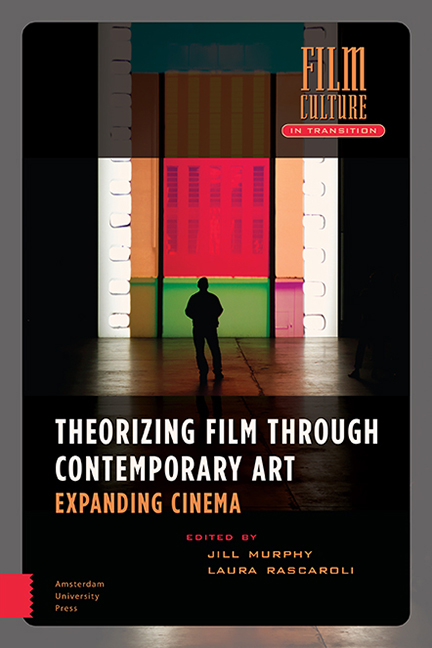Book contents
- Frontmater
- Dedication
- Contents
- List of Illustrations
- Acknowledgments
- Foreword: Courtesy of the Artists
- Introduction: On Cinema Expanding
- Part One Materialities
- 1 Cinema as (In)Visible Object; Looking, Making, and Remaking
- 2 Objects in Time; Artefacts in Artists’ Moving Image
- 3 Materializing the Body of the Actor; Labour, Memory, and Storage
- 4 How to Spell ‘Film’; Gibson + Recoder’s Alphabet of Projection
- Part Two Immaterialities
- 5 The Magic of Shadows; Distancing and Exposure in William Kentridge’s More Sweetly Play the Dance
- 6 Douglas Gordon and the Gallery of the Mind
- 7 A Throw of the Dice Will Never Abolish Chance; Tacita Dean’s Section Cinema (Homage to Marcel Broodthaers)
- Part Three Temporalities
- 8 The Photo-Filmic Diorama
- 9 The Cinematic Dispositif and Its Ghost; Sugimoto’s Theaters
- 10 Time/Frame: On Cinematic Duration
- Part Four The Futures of the Image
- 11 Interactivity without Control; David OReilly’s Everything (2017) and the Representation of Totality
- 12 Post-Cinematic Unframing
- 13 Absolute Immanence
- Index
12 - Post-Cinematic Unframing
Published online by Cambridge University Press: 23 June 2021
- Frontmater
- Dedication
- Contents
- List of Illustrations
- Acknowledgments
- Foreword: Courtesy of the Artists
- Introduction: On Cinema Expanding
- Part One Materialities
- 1 Cinema as (In)Visible Object; Looking, Making, and Remaking
- 2 Objects in Time; Artefacts in Artists’ Moving Image
- 3 Materializing the Body of the Actor; Labour, Memory, and Storage
- 4 How to Spell ‘Film’; Gibson + Recoder’s Alphabet of Projection
- Part Two Immaterialities
- 5 The Magic of Shadows; Distancing and Exposure in William Kentridge’s More Sweetly Play the Dance
- 6 Douglas Gordon and the Gallery of the Mind
- 7 A Throw of the Dice Will Never Abolish Chance; Tacita Dean’s Section Cinema (Homage to Marcel Broodthaers)
- Part Three Temporalities
- 8 The Photo-Filmic Diorama
- 9 The Cinematic Dispositif and Its Ghost; Sugimoto’s Theaters
- 10 Time/Frame: On Cinematic Duration
- Part Four The Futures of the Image
- 11 Interactivity without Control; David OReilly’s Everything (2017) and the Representation of Totality
- 12 Post-Cinematic Unframing
- 13 Absolute Immanence
- Index
Summary
Abstract
What becomes of the frame in an era of post-cinema? This chapter explores that question and possible answers as suggested by two exemplary post-cinematic moving-image works, Camille Henrot's single-channel video installation Grosse Fatigue (2013) and Kevin B. Lee's video essay Transformers: The Premake (2014). The proliferation of frames in these works enacts an itinerary of the aesthetic strategy I call ‘post-cinematic unframing’ that particularly comes to the fore when framing is explicitly thematised – as it is, for example, when pop-up bubbles are superimposed on a scene to display characters’ text messaging, or by superimposing, stacking, juxtaposing, and collaging images.
Keywords: Digital media, post-cinema, video essay, framing, installation art
What is the role of the frame in contemporary moving-image cultures? Camille Henrot's single-channel video installation Grosse Fatigue (2013) answers that question in the plural. It locates not so much the frame as frames at the centre of moving-image cultures marked by digitally facilitated transformations in industry, technology, and social practice. Grosse Fatigue won the Silver Lion at the 55th Venice Biennale in 2013, where it was presented as part of the exhibition Il Palazzo Enciclopedico (The Encyclopedic Palace). The thirteenminute video, displayed in a darkened cinema-like room, confronted visitors with a multiplicity of windows stacked on-screen, one on top of the other. The frame-on-frame presentation mimicked Apple and Microsoft graphical user-friendly interfaces, which model interactivity in terms of attention and activity clustered around stacked mobile frames. More specifically, by revealing an endless series of frames, the images of Grosse Fatigue recalled the pop-up browser windows that have circulated on the World Wide Web since the 1990s, with their characteristic ‘x's in the upper left or right corner.
Grosse Fatigue and indeed a substantial number of what I will define below as ‘post-cinematic works’ do not simply multiply frames as if to enhance or amplify the pre-existing logic of the cinematic frame. These postcinematic works include strictly digital works, to be sure, but also movies, television programmes, art installations, games, and even sound recordings employing framing, stacking, and layering strategies that have a parasitic reliance on cinematic protocols even as they explore the new technical and aesthetic tactics of contextualization emerging in contemporary media cultures.
- Type
- Chapter
- Information
- Theorizing Film Through Contemporary ArtExpanding Cinema, pp. 255 - 276Publisher: Amsterdam University PressPrint publication year: 2020



